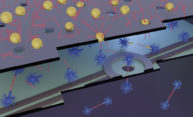Smaller is better for detecting biomarkers of trauma and cancer

An inexpensive but highly sensitive biomarker detection system is being developed in a collaboration between the University of Rochester, the University of Ottawa, and Rochester-based SiMPore Inc. The team is using highly sensitive solid state nanopores to detect biomarkers of traumatic brain injury, bladder cancer, and other acute disorders in serum and urine. As illustrated in this cutaway view, the technique involves amplifying the biomarkers into DNA proxies (magenta spirals) coupled to gold nanoparticles. The gold nanoparticles are captured and concentrated on an ultrathin membrane (purple) with many nano-sized pores. UV light is then used to release the proxies, which bind to DNA-origami nanostructures (blue). The proxy-nanostructure combination gives unique signals that identify the biomarkers present in the original sample as they pass through the single nanopore sensor (green).
